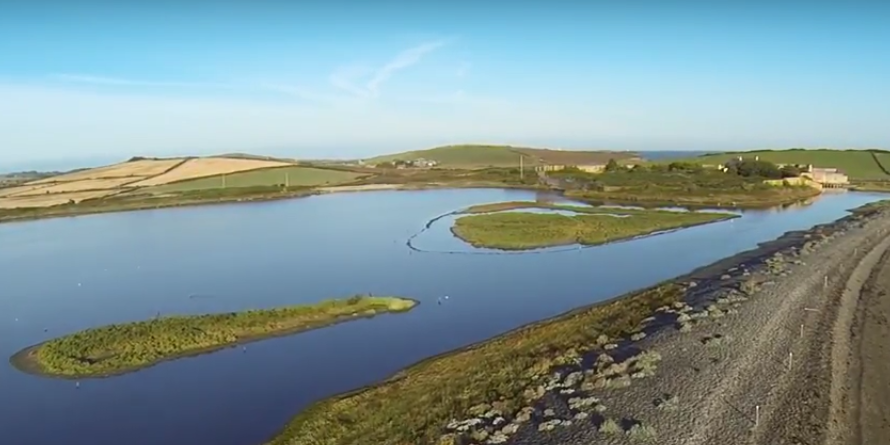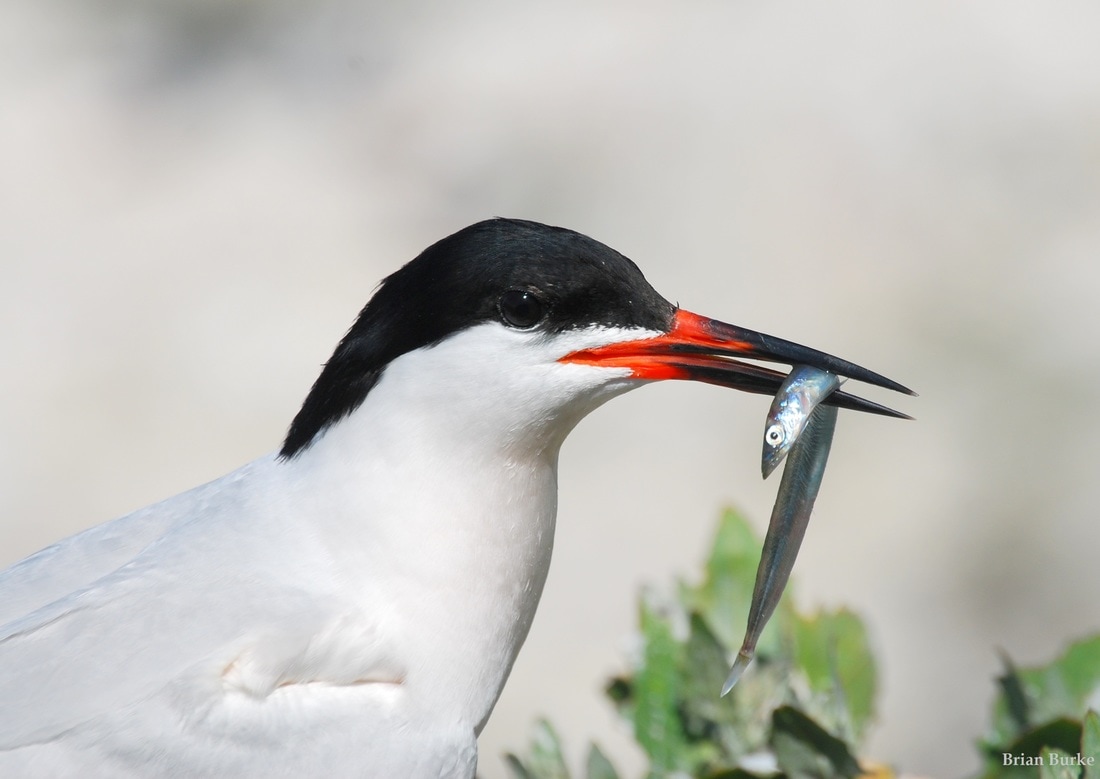|
Mae newyddion yn trafaelio yn cyflym yn nghymuned yr adarwyr – newyddion drwg hyd yn oed yng hynt. Yn Cemlyn mae hi ‘n dra ddistaw. Yn gynharach eleni ac yn dilyn amrediad o dymhorau bridio gwych, gosodwyd Ymddiriedolaeth Natur Gogledd Cymru, gyda chymorth gan Prosiect LIFE y Môr-wennol wridog, rafftiau ar y lagŵn yng Nghemlyn. Mesur gweithredol oedd hyn i annog y môr-wennol gyffredin, i amddiffyn adar bridio yn erbyn cael eu rheibio ac i leddfu “pwysa” ar y safle nythu gan fod nythfa’r môr-wennoliaid pigddu yn tyfu’n gyson. Cynamserol roedd ein gobeithion cynnar am 2017 ac rydym yn dra siomedig i orfod adrodd, er y cychwyniad da, y bod 2017 wedi bod yn flwyddyn anodd dros ben ac mae’r môr-wennoliaid wedi gadael eu nythod ac wedi gwasgaru. O ganol mis Mai ymlaen, fe ddaeth hi yn amlwg fod yr ynysoedd yn y lagŵn yng Nghemlyn yn cael eu poenydio gan ddyfrgwn – rhywogaeth sydd , fel y môr-wennoliaid, yn elw o amddiffyniad llywodraethol gre. Yn y dechrau targed yr ysglyfaethu oedd nythod y gwylanod penddu ond, fe oedd yr aflonyddwch a’r cynnwrf oedd wedi gael eu creu gan y rheibwyr hyn wedi cadw’r gwylanod ar môr-wennoliaid i ffwrdd o’r ynysoedd a’i nythod am gyfnod maith, yn aml ar nosweithiau gwlyb ac oer. Mae ysglyfaethu cytunedig ac hir dymor o rywogaethau amddiffynnol gan rywogaethau amddiffynnol arall yn creu penbleth rheolaeth cymhleth i Ymddiriedolaeth Natur Gogledd Cymru. Yn dilyn trafodaethau hefo Cyfoeth Naturiol Cymru, gwneuthum nifer o ymdrechion i rwystro y rheibwyr ond ar y cyfan profodd rhain yn aflwyddiannus. Fel aeth y tymor bridio yn ei flaen fe aflonyddodd y môr-wennoliaid yn fwy-fwy ac fe grëwyd y nifer y nythod gweigion ragor o gyfleodd o reibio gan frain a gwylanod mawr. Cafwyd y rhan fwyaf o’r prif ddarn y cytref môr-wennoliaid ei adael erbyn 17ain o Fehefin ond, fe ymdrechodd môr-wennoliaid cyffredin, y Gogledd a’r bigddu nythu ar yr ynys leiaf yn y lagŵn. Er bod yna ffens wedi eu chodi i amddiffyn yr adar, yn y diwedd fe adawodd yr adar hyn hefyd . Nid yw rheibio ac aflonyddwch gan famaliaid y tir ac adar ar ffasiwn raddfa mor unigryw yng Nghemlyn neu gytrefi eraill; y digwyddiadau tebyg blaenorol yng Nghemlyn oedd yn 2007 a 2008. Yr adeg hyn y prif “droseddwyr” oedd crehyrod a gwyddau. Y peth pwysig nawr, fel yr oedd adeg hynny, y dylid Ymddiriedolaeth Natur Gogledd Cymru ragweld ac ymateb i’r bygythiad o reibio. Fe fydd cynlluniau a mesuriadau hir dymor i amddiffyn y cytref mewn lle cyn i’r môr-wennoliaid ddychwelyd yn y Gwanwyn o 2018. Drwy gyd-weithio hefo mudiadau eraill gyda phrofiadau yn y maes hyn, fe fyddem yn gosod cyfres o fesurau mewn llaw er mwyn sicrhau y bydd môr-wennoliaid Cemlyn yn cael cyn gymaint o amddiffyniad ar siawns gorau o fridio a sydd bosib; wrth gwrs fe fydd y mesurau hyn yn cael eu trwyddedu’n briodol ac wedi eu caniatáu gan Gyfoeth Natur Cymru fel y awdurdod statudol amgylcheddol a trwyddedu rhywogaeth . Wedi rhoi gorau i fridio mae oedolion y môr-wennoliaid nawr yn bwrw eu plu ac wedi symud i ffwrdd o Gemlyn . Maent yn parhau i fwydo ar y heigiau o lymrïaid a silod mân o gwmpas arfordiroedd Ynys Môn. Yn yr wythnosau byr o’n Haf, mae’r nifer o bysgod o gwmpas arfordiroedd Ynys Môn yn rhoi nerth a maeth iddynt am y siwrnai hir i’r De.
Rydym yn gofyn i’n cymunedau arfordirol, pysgotwyr môr, cerddwyr ar Lwybr Arfordirol Môn a ein gwylwyr bywyd gwyllt gadw golwg allan am heidiau o fôr-wennoliaid pigddu – diddorol fydd gwybod ym mhle maent yn treulio amser cyn iddynt fudo i’r de am y gaeaf. Guest Blog by Alison - Swyddog Cymunedol y Môr-wennol gwridog
0 Comments
Are you interested in seeing some of the stunning seabirds in the Firth of Forth? Why not consider the RSPB's Seabird Cruises which are available during the summer? South Queensferry Cruises Join the RSPB aboard the Maid of the Forth for a 3 hour fun and fact filled trip around the islands of the Forth. Starting under the iconic Forth bridges we will sail east past Inchgarvie, Inchcolm and Inchmickery out to our turning point at Inchkeith. Along the way we are sure to see many of the birds that make up the fantastic seabird colonies found in the forth including puffins, fulmars, eiders and shags as well as seals hauled out on buoys, terns fishing and we may even catch a glimpse of peregrine falcon hunting. With in-depth commentary from RSPB experts bringing the environment to life, it’s sure to be a fun and fact filled cruise! Cruises sail on Sunday 4th June and Sunday 2nd July at 6pm. North Berwick Cruise Hop aboard the ‘Seafari Explorer’ catamaran for a two hour trip around the fascinating Forth islands. Sailing from North Berwick harbour we will first head west towards Fidra, said to the inspiration for Robert Louis Stevenson’s treasure island and now a RSPB nature reserve, before turning to head back towards Craigleith and on towards the Bass rock, the world’s largest colony of Northern gannets and ‘one of the wildlife wonders of the world’. We will see gannets fishing, seals basking and puffins galore as we see hear and smell the wildlife spectacle that helps make the forth such a special place. Cruise sails on Saturday 17th June at 6pm. Cost?
The North Berwick cruise is £20 for adults (RSPB members £18) and £12 for children. The South Queensferry cruise is £18 for adults (RSPB members £16) and £7 for children. Family tickets (two adults and two children) are £40. To book, visit maidoftheforth.co.uk or for more information call 01324 832853 Today's guest blog is by Lizzy Green and the Sandeel literature review she has been working on: "I’m a Species and Habitats Officer on the Roseate Tern Life Project in the Nature Recovery Unit and have been working with the RSPB since January 2017. The main objective of my role is to improve our understanding of tern diets around the British Isles by gathering and synthesising information from the peer-reviewed and grey literature. This involves collating information on what terns are eating, how this varies spatially, temporally and between species, and how this variation in diet affects tern breeding success. I am also analysing the impacts of diet on tern productivity using a long-term data set of Arctic tern chick provisioning from two sites on Anglesey. However, another crucial aspect of my role is gathering ecological information about key prey species for terns, such as the lesser sandeel (Ammodytes marinus). The lesser sandeel is one of the most important prey species for seabirds around the UK, providing a high-lipid food source that, due to its long, thin body shape, is easy for chicks to swallow. However, the availability of sandeels fluctuates between years and can have severe impacts on seabird breeding success, particularly for populations with little or no access to alternative prey. Further, adult sandeels demonstrate limited dispersal ability and high habitat specificity, rendering this species vulnerable to local depletion and climate-driven reductions in their zooplankton prey. In this literature review I collate information on the ecology, status, and distribution of the lesser sandeel, consider the drivers of inter-annual variation in populations, summarise evidence demonstrating the importance of the species for seabirds and discuss the current and potential impacts of climate change, fisheries and other factors on sandeel populations."
|
More Blogs to Read
AuthorThis blog is maintained by various people from the project team. Archives
August 2020
Categories
All
|
||||||
Roseate Tern LIFE Project is supported by the LIFE Programme of the European Union
LIFE14 NAT/UK/000394 ROSEATE TERN
LIFE14 NAT/UK/000394 ROSEATE TERN







 RSS Feed
RSS Feed